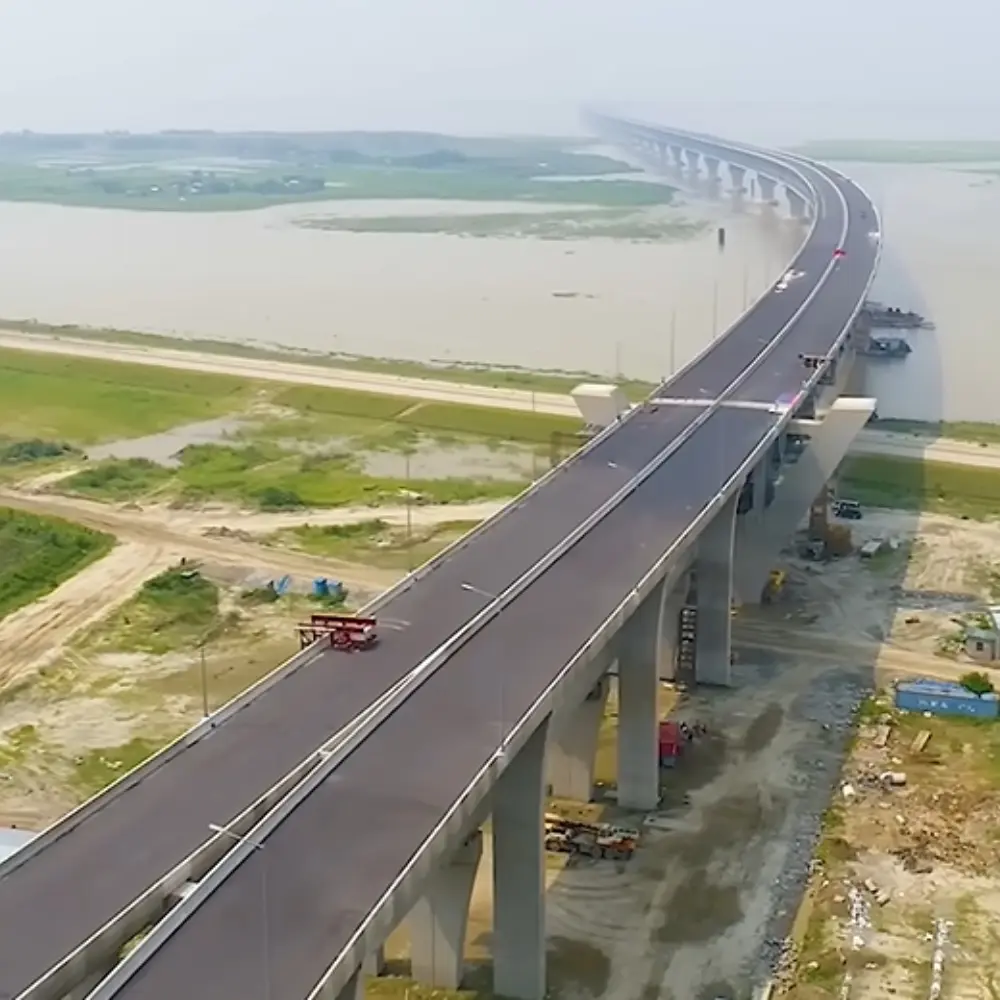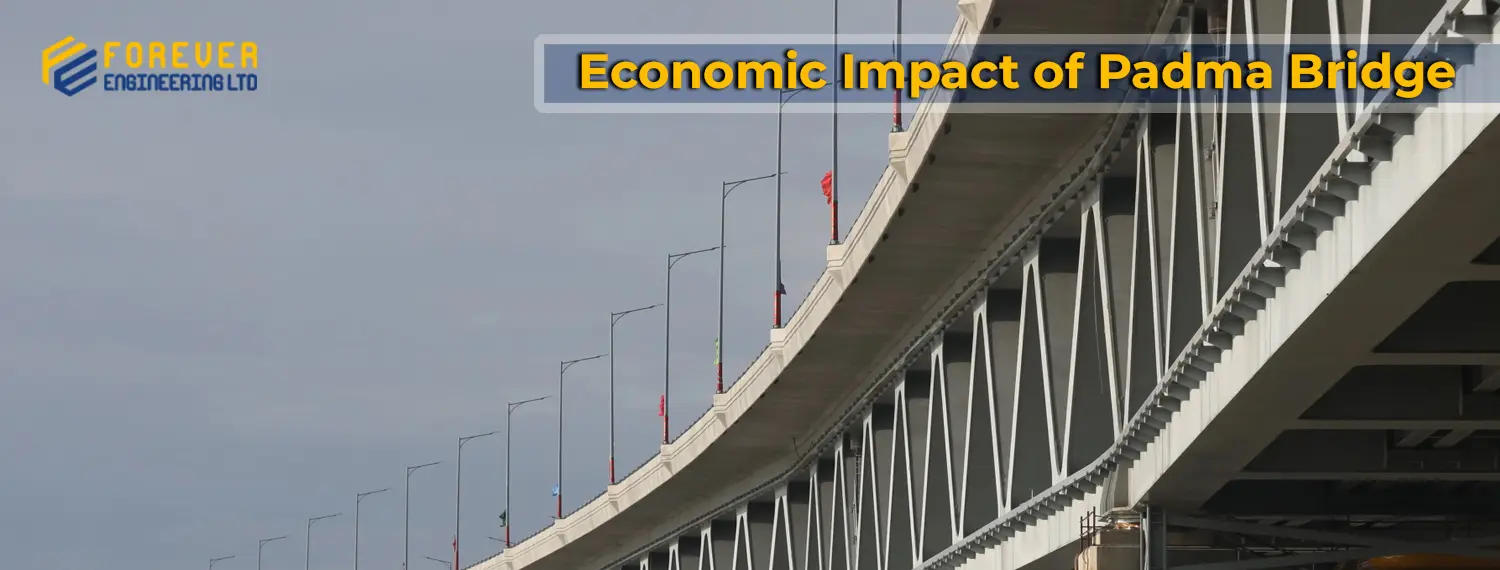The Padma Multipurpose Bridge is a dream of Bangladesh’s people, especially the people of the country’s southern part. The construction of the Padma Bridge would benefit the broad people in Bangladesh and The Southwest at the very least.
The benefits are projected from the predicted increase in allowing more market shares within the Southwest market to integrate with the national economy of Bangladesh.
The Padma Bridge is more than just a physical structure; the Bridge is the change. It is instrumental in the social, economic, and industrial development of this underdeveloped most densely populated region where over 30 million live here.
Indeed, it is a vital project but also a game changer. The project would provide the vital infrastructure for the country’s transport network and lateral economic development.
Today, we are going to reveal the Economic Impact of Padma Bridge on Bangladesh. So, let’s get started to learn how Padma Bridge impacts Bangladesh’s economy.
Story of Padma Bridge
Table of Contents
Toggle
The Padma Multipurpose Bridge is mainly known as the Padma Bridge. This is a two-level road-rail bridge that crosses the Padma River, Bangladesh’s main Ganges distributary.
On November 26, 2014, the Bangladesh Bridge Authority began building the Padma Bridge. China Major Bridge Engineering Company Limited completed the primary bridge construction, utilizing AECOM’s design (Bangladesh Bridge Authority, 2022). The construction took 2765 days and cost BDT 301933.88 million.
It connects Munshiganj’s Louhajang Upazila, Shariatpur’s Zazira Upazila, and a small portion of Madaripur’s Shibchar Upazila. It connects the country’s less-developed southwest with its northern and eastern regions. On the morning of June 25, 2022, Prime Minister Sheikh Hasina officially opened the bridge.
The bridge is thought to be the most difficult construction project in Bangladesh’s history. The steel truss bridge connects a four-lane highway on the upper level to a single-track railway on the lower level. The bridge is made up of 41 sections, each 150.12 meters (492.5 feet) long and 22 meters (72 feet) wide, for a total length of 6.15 kilometers (3.82 miles).
It is the longest bridge over the Padma River (and, by extension, Bangladesh). It is the world’s longest bridge in terms of both span and total length, with the most profound pile depth of any bridge at 127 meters (417 feet). The construction of this bridge was challenging due to specific constraints with the width and depth of the Padma River.
The Main Impact of Padma Bridge On Bangladesh
The Padma Bridge has a significant impact on the whole country. It helps to drive the southwest region’s socioeconomic and industrial development. It has improved connectivity between these regions of the country and the capital. It also increases socio economic impact of Padma Bridge.
The bridge is unique in that it was built over a complex river system that separated the southwestern region from Bangladesh’s most important economic hubs. Nearly 30 million people in the country’s southwest saw their lives altered by the Padma Bridge. It also encouraged contemporary and commercial activity and increased employment and economic prospects.
- Farmers are getting fair prices
- Transport costs, time reduced
- Investment in transportation increases
- Housing sector booming
- Two new EPZs are being set up
- 17 new economic zones are forming
- RMG gets a new route through Mongla Port
Now let’s know about Padma Bridge and the Economic Impact of Padma Bridge. Take a closer look in the below section to learn more.
Economic Impact of Padma Bridge on Bangladesh
The economic impact of Padma Bridge is uncountable. The Padma Bridge is more than just a structure; it is a driver of economic growth in the Southern region. It will boost Bangladesh’s GDP by 1.23% and the regional economy by 2% in 21 southwestern districts. The bridge’s economic benefits would total more than $10 billion over its lifetime, more than three times its construction cost. Padma Bridge contributes to 29% growth in construction, 9.5% in agriculture, and 8% in manufacturing and transportation.
It would be an essential catalyst in implementing the government’s Vision 2041. This is become a high-income country. It will create 7.5 lakh new jobs in 17 special economic zones planned in 21 districts. It contributes significantly to poverty reduction.
Moreover, the bridge will serve as a crucial link to the Padma Rail Link Project, a transformative initiative that is poised to elevate Bangladesh into a key sub-route of the trans-Asian rail network. This strategic move is projected to accelerate GDP growth by approximately 1 percent, opening up new avenues for economic development. It will also foster stronger regional ties, enabling Bangladesh to maintain a robust railway network with Bhutan, Nepal, and India.
The Economic Impact of Padma Bridge development on travel time is significant. Commute between the Dhaka division and the southwestern region is expected to be reduced by about two hours for cars and buses, and a staggering over 10 hours for trucks. According to a study conducted by the Japan International Cooperation Agency, a 10% reduction in travel time to and from Dhaka could increase the region’s economic output by 5.5 percent, highlighting the project’s tangible benefits.
The Bangladesh Economic Zones Authority is developing 17 economic zones in the region to accelerate industrialization and economic growth. These areas will cover all of the southwestern districts.
There will be increased hiring, re-skilling, or up-skilling of the labor force in accordance with industry needs and a hike in the minimum wage as the demand for labor rises. Hence, more economic opportunities will ultimately improve living conditions and thus reduce poverty.
Impact on Poverty Reduction and Jobs
Bangladesh has already made some progress, and it will make even more in the coming years. With a rapidly expanding GDP, the country’s per capita income has far surpassed that of many of its neighbors, and the rate of need has declined. Bangladesh outperforms South Asia and other LDCs in terms of specific social indicators. From 2000 to 2015, the country made significant progress toward meeting the Millennium Development Goals.
13 of the districts have higher poverty rates than the national average. In 2011, the Asian Development Bank reported that the southwestern districts have approximately 5% more people living below the poverty line than the rest of the country. Nonetheless, the opening of the Padma Bridge is expected to reduce poverty rates both nationally and regionally.
In a 2011 study, the World Bank predicted that the poverty reduction rate would increase by one percentage point in the region and 0.8 percentage points nationally.
Agriculture and agro-processing-based industrialization offer significant opportunities for the region. Mobilizing agricultural investment will be beneficial as the southwestern region contributes a larger share of GDP to agriculture.
A wide range of small and large industries, including ready-made garments, information technology, and logistics, have the potential to thrive in the region. The industrial expansion will have a spillover effect in the form of network economies, which will benefit cottage, micro, small, and medium-sized businesses (MSMEs). If the CMSMEs integrate with the local production systems, they will be able to connect with other businesses and support organizations while also benefiting from economies of scale in purchasing, production, and distribution.
Increased access to markets and resources will improve CMSMEs’ sustainability. It allows them to grow through increased productivity and profitability.
The Connection Between Electricity, Gas, and Telecommunications
The Padma Bridge construction is causing problems with power, gas, and telecommunications. The Padma multifunctional bridge currently serves as the connection point between the nation’s southwest and the public forces network.
Thus, this massive amount of power will be responsible for the current economy and rapid industrialization. In any case, the Padma Bridge will allow automobiles to cross waterways and link railway lines with channels for energy, broadcast communications, and LPG transfer.
The bridge will also facilitate province-level trade by cutting down on the amount of time it takes to get from Dhaka to Kolkata. The construction of the bridge might contribute to the enhancement of the southwest port of Mongla, which functions somewhat as planned. This will benefit the Northwestern areas and give Dhaka an option for ports.
Forever Engineering’s Role in Constructing Mega Project
Forever Engineering Ltd is a partner in nation-building and not just a construction company. We work on various mega projects in Bangladesh like Mirsarai Economic Zone. The Padma Bridge symbolizes more than simply the country’s physical infrastructure—rather, it embodies Bangladeshis’ hopes and dreams for a better future. We are grateful to be a part of this life-changing experience and are steadfast in our commitment to finishing each job to the highest standard.
Are you ready to embark on the construction project of your dreams? Do you have any questions about project management, supplies, or construction methods? Look no further! At Forever Engineering Ltd, we are always ready and eager to help you at every step of your journey.
Whether you are a contractor, developer, or homeowner, our team of professionals is ready to ensure tailored advice and solutions to meet your specific demands. We offer comprehensive customer support from start to finish, ensuring the successful realization of your construction goals.
Please get in touch with us with any questions you may have, and allow us to assist you in realizing your dreams. We can create a better future together.
Conclusion
The Economic Impact of Padma Bridge on Bangladesh is significant and wide-ranging. Its completion, the biggest infrastructure project in Bangladesh’s history, marks a critical turning point in the nation’s progress towards wealth and economic growth.
Beyond its financial impact, the Padma Bridge also has symbolic importance. It stands for Bangladesh’s dedication to advancement, innovation, and modernization. Its unique edifice is a source of pride for its residents and represents the country’s hopes for a better future.

